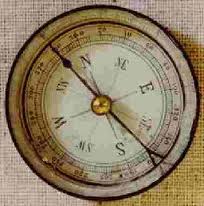Magnetic Compass

A magnetic compass is an absolute essential for your bug out bag as it will help you navigate to your base camp if all electronic devices and satellite navigation systems have been knocked out. Learning how to use a compass is very simple and after an hour or two out in the field, you should feel comfortable enough to use one in conjunction with a map to help you explore the area around your base camp for food and water sources without getting lost.
How It Works
Magnetic compasses have been around for centuries, ever since people worked out that by charging a piece of metal, it would move around on it's own accord. Of course, we now know that a magnetic compass responds to the pull of the earth's magnetic field, which is currently in line with the north and south poles.
Your compass will be a charged strip of metal that is allowed to float freely either in water, liquid or a vacuum. The metal strip will be polarized meaning that the negatively charged end will always swing round and point to magnetic north. You can then match your position and heading up to your map and follow your trail successfully.
Make Your Own Compass
Realistically, even the cheapest magnetic compass should last almost indefinitely as there is no way for them to lose their charge. However, in a survival situation, things can get broken or damaged or lost, so you may find that you need to make your own compass:
- Equipment - you'll need a thin strip of something made from steel, such as a needle, nail or pin. Anything that is not magnetic will not work as a compass point. You'll also need something that floats like a cork or a sponge for the metal to rest on as the thinness of the metal object means that it won't float alone. Finally, you'll need a container, such as a cup or bowl, filled halfway with water. Make sure that your floating object can freely rotate on the surface of the water.
- Charging the compass - you'll then need to charge the compass pointer. The easiest way to do this is to pass another magnet from one to the other in the same direction around 20 times. However, you may not have a magnet to hand, but you can use a D cell battery to generate a magnetic field. Wrap some copper wire around a nail and attach either end of the wire to the positive and negative terminals on the battery. You can then use the nail in the same way as a magnet to provide the charge for your compass pointer.
- Testing - you'll then need to test the compass to make sure that it's pointing to magnetic north. The first test will be to see if you've given it enough charge, and you'll see the answer to this when you put the pointer on your floating object. If it rotates of its own accord, it's responding to the earth's magnetic field. If it doesn't, you'll need to charge it up some more. Once it's rotating, you'll need to check which end is pointing north. You can do this by comparing the bearing to a known position on a map such as your base camp or a food cache.
It is definitely worth the time and effort to practice making your own magnetic compass out of day-to-day objects ahead of time so that you have the skill set for a survival situation. This will be a fairly unique skill which you'll be able to barter for goods and other services with fellow survivors.
Return from Magnetic Compass to Survival Bug Out





New! Comments
Have your say about what you just read! Leave me a comment in the box below.